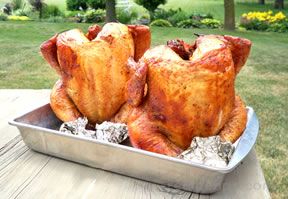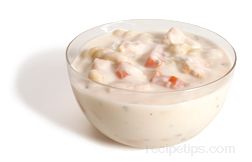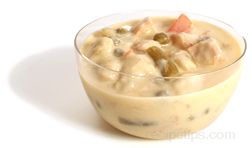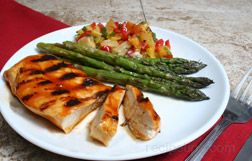|
Frying chicken is a quick and simple way of cooking chicken where the cooking can be accomplished by the use of two different methods, pan-frying and deep-fat frying. Both methods work on the principle of using hot oil to cook the chicken, producing chicken with a crispy brown outside and juicy, flavorful meat inside. The chicken is generally coated with a thin layer of flour, crumbs or batter. Chicken pieces are generally used for frying, rather than a whole chicken. Pan-Frying: When pan-frying, a heavy skillet with deep sides is generally used. The chicken pieces are coated with flour that has been seasoned with salt, pepper and at times, paprika. It can also be seasoned with other spices, such as chili or curry powder, marjoram, oregano, basil, thyme, and rosemary to create a desired flavor.
As the pieces finish cooking, they should be removed from the pan and placed on a paper towel to allow grease to drain. The chicken can be checked for proper doneness using one of three methods. The best way to check for doneness is to use a meat thermometer. Chicken breast must reach 170°F and other pieces should be 180°F. If a meat thermometer is not available, a visual test can be performed by piercing the pieces with a fork. If thoroughly cooked, the juices should run clear. Doneness can also be checked by cutting into the thickest part of the chicken and making sure the meat is opaque all the way through.
To fry, fill a deep pan approximately half full of oil and heat to between 350°F and 375°F. To test the temperature, drop in a cube of bread, it should brown in 50 seconds if the oil is about 365°F. Using tongs or a metal spatula, place three to four pieces of chicken in the hot oil, being careful that they are not overcrowded. Cook until golden brown, approximately 6 to 10 minutes. As the pieces of chicken get done, remove them from the oil and place them on a paper towel to allow the grease to drain. When using either method of frying, an important part of the process is keeping the oil at the proper temperature. Once the chicken is placed in the hot oil, the temperature of the oil will drop. But, as long as the oil continues to bubble consistently, it will cook the chicken properly. If the temperature of the oil would be brought back up to between 350°F and 375°F, the outside of the chicken would burn before the inside finished cooking. To prevent this from happening, the temperature may need to be turned down a little once the chicken starts browning, but make sure the oil stays hot enough. If the oil is not hot enough, the chicken will be greasy. Controlling the temperature of the oil is an important part of producing delicious fried chicken. Shown below are some additional tips on frying chicken.
|
Loading
Frying Chicken
Loading
There currently aren't any reviews or comments for this article. Be the first!
Popular Recipe Pages
Popular Recipes
Advertisement
Advertisement



















